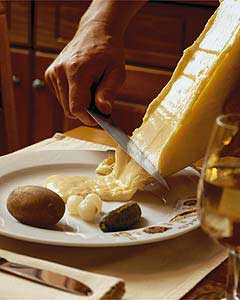Facts About Raclette
Raclette is a delicious semi-hard cheese made from Alpine cow's milk, ideal for melting or enjoying in slices. It is also the name of a Swiss dish where the cheese is heated until it melts and then scraped off for serving. This delightful tradition dates back to medieval times and was first mentioned in Swiss convent texts from 1291. It originated with Alpine peasants who called it "roasted cheese" in the German-speaking regions of Switzerland. Back then, cow herders would soften the cheese by the campfire and scrape it onto bread.
In Switzerland, raclette is typically served with potatoes, cornichons (tiny pickles), pickled onions, warm beverages, or a glass of Fendant wine. In France, it is commonly paired with white wine. The Swiss usually prepare it by continuously melting and scraping the cheese from an oven, whereas the French often use a raclette oven placed right on the table so guests can scrape the cheese themselves.
Traditionally, raclette cheese is heated in front of a fire, and the melted cheese is scraped onto plates, accompanied by potatoes, cornichons, pickled onions, and dried meats. Nowadays, many people use an electric table-top grill with small pans to melt individual slices of raclette cheese—a method that has been popular since the 1950s. Raclette cheese is protected by a PDO (Protected Designation of Origin) and is produced in various regions around the world.
There are different versions of raclette, such as "vercouline" which uses Bleu du Vercors-Sassenage cheese, and other variations that incorporate PDO cheeses like Bleu de Gex and Morbier. Raclette is made in several countries, including Switzerland, France, Luxembourg, Austria, Germany, Finland, Australia, Canada, and the United States.

 Liechtenstein
Liechtenstein